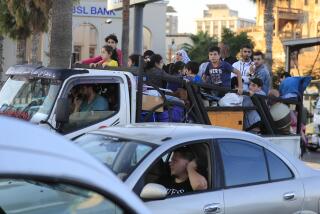Thousands Mass in the Hope of Thwarting Eviction
NETZER HAZANI, Gaza Strip — On a patch of sun-scorched sand, two rows of green tarpaulin shelters serve as barracks for some of the army of protesters who have poured into Gaza to stymie Israel’s planned removal of Jewish settlers this week.
Several thousand newcomers, mostly religiously observant teens as well as couples with small children, have entered Gaza in defiance of Israeli authorities, who view the outsiders as a worrisome wild card and possible source of forceful resistance.
Israeli officials say as many as 5,000 people have slipped past layers of police and army checkpoints, a number more than double the government’s previous estimates. Settler leaders say the total could be even higher.
Coping with thousands of protesters, labeled “infiltrators” by Israeli officials but “visitors” by many settlers, could prove as big a task as removing residents. At least half of the 8,500 settlers remained as of Sunday, although some were expected to move before the Wednesday deadline for voluntary departure.
Ousting the protesters could prove an early test of the military’s evacuation plans, and Israeli officials say they will clamp down against further entries. But settler leaders have called on followers to flood into Gaza early this week. Though many residents say they are moved by the show of support, some worry privately about the possible disruption the protesters might cause.
The new arrivals say they came to support the settlers’ claims that the land was given to them by God, and to do what they can to stop the evacuation.
Settler leaders insist that any resistance will be nonviolent. Some protesters say they plan to crowd in front of army trucks and buses to block them from settler neighborhoods. Others hope they can discourage troops from carrying out the mission by appealing to their common Jewish identity.
“We’re going to try to talk to the soldiers, talk to them as our brothers, that we’re their brothers and all the people who live here are their brothers,” said Roi Koren, a 17-year-old high school student from Raanana, outside Tel Aviv, who sat Sunday with friends at a picnic table in the Netzer Hazani encampment.
Roi slipped into Gaza just over a week ago after first being turned away because he was not a resident of the main settlement block, Gush Katif. For the last month, the block has been off-limits to nonresidents except for those with special permits.
Roi said he waited near Gush Katif’s checkpoint for hours until he managed to hitch a ride through it undetected.
Anti-pullout protests have assumed the air of a social happening across Israel and in the occupied territories, especially among religious youth, and the makeshift villages now dotting half a dozen settlements and the beach have the look of a mini-Woodstock.
The tent drive has coincided with Israel’s summertime school vacation, swelling the number of teens and families with school-age children.
At a beachside site near the Shirat Hayam settlement, dozens of families endure sweltering Mediterranean heat in densely packed tents and tarp shelters, gathering under a few shaded areas to eat. For most people, accommodations are bare-bones, with services limited to portable toilets and improvised showers.
A camp at the Kfar Darom settlement was a bit better off -- it was wired for electricity, allowing campers to cool their tents with fans. One of the women staying there, Rachel Golan, 42, moved in with 10 children. It wasn’t easy camping amid the dust and preparing meals on a gas stove, Golan said last week, but she felt duty-bound to stick it out.
In Netzer Hazani, Yehuda Goldfield of Jerusalem said he hoped to somehow impede the arrival of army vehicles when the evacuation got underway, but vowed he would not use violence.
“I can’t fight any soldier. I can’t hit him. I can’t punch a soldier,” said Yehuda, a lanky 17-year-old with a sparse spray of chin whiskers.
Netzer Hazani’s leaders met recently with the newcomers and spelled out some general rules -- among them that protests were to remain nonviolent.
The influx has suddenly doubled Netzer Hazani’s normal population of about 650. Some of the arrivals are bunking with families, while many others are sleeping in the settlement’s wedding hall, with room dividers fashioned from sheets.
Yehuda arrived two weeks ago, posing as the son of a Gush Katif settler. He slept in one of the tent shelters before moving indoors a few days ago with a family. Since getting to Netzer Hazani, Yehuda has busied himself by volunteering to baby-sit and venturing out to meet other young people.
“If you put aside all the soldiers and things, it’s like a summer camp for two weeks,” he said. “You have the beach, friends.”
The youths chuckled at the Hebrew term used to describe them, shabachim, which comes from a government acronym referring to people staying illegally. The same term is used for Palestinians who enter Israel without permits.
They grew serious when talk turned to the possibility of bloodshed. Roi, the teen from Raanana, said he could think of no one who might cross “red lines” by attacking soldiers or police. But he conceded that authorities’ concerns might be warranted.
“I hope that no one will cross these lines,” he said. “But there could be some stupid kids looking for action.”
More to Read
Sign up for Essential California
The most important California stories and recommendations in your inbox every morning.
You may occasionally receive promotional content from the Los Angeles Times.










